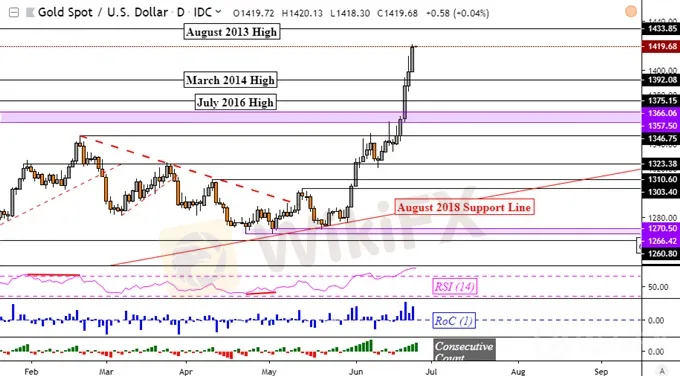简体中文
繁體中文
English
Pусский
日本語
ภาษาไทย
Tiếng Việt
Bahasa Indonesia
Español
हिन्दी
Filippiiniläinen
Français
Deutsch
Português
Türkçe
한국어
العربية
Gold Prices Target Late-2013 High as Yield Curve Inversion Widens
Abstract:Gold prices target August 2013 highs as US recession fears rise and local bond yields tumble. The GBPUSD is aiming lower as Boris Johnson comments on Brexit ahead of the APAC session.
Asia Pacific Market Open Talking Points
Gold prices target August 2013 high as US recession fears rise and bond yields fall
NZDUSD and AUDUSD maintain gains despite S&P 500 struggle near record-highs
GBPUSD lower as Boris Johnson comments on Brexit, Asia stocks may trade mixed
Trade all the major global economic data live as it populates in the economic calendar and follow the live coverage for key events listed in the DailyFX Webinars. Wed love to have you along.
Gold Prices Extends Rally as US Recession Fears Rise
Gold prices are up over 11 percent from the bottom in late April, extending recent aggressive behavior as US government bond yields continue falling in the aftermath of last weeks Fed monetary policy announcement. On Monday, it was no different as the anti-fiat precious metal climbed and the US Dollar aimed cautiously lower.
Yet, Wall Street was unable to capitalize on prospects of easing from the central bank, with a July interest rate cut fully priced in by Fed funds futures. The S&P 500 fell 0.17 percent as it kept struggling to hang on to a record-high close. The spread between 10-year and 3-month bond yields, which remains inverted since May 23, widened after narrowing for three days in a row, possibly indicating rising bets of a US recession.
Gold Technical Analysis
Looking at a gold daily chart, XAUUSD confirmed another close above March 2014 high at 1392. Prices are quickly approaching the August 2013 high at 1433. From a technical standpoint, golds upside momentum picked up pace after testing the rising support line from August 2018, further solidifying it as key support in the event of a downturn in the medium-term.
Gold Daily Chart

*Charts Created in TradingView
Despite the rather lackluster performance in European and US equities, the pro-risk Australian and New Zealand Dollars aimed little higher. The former was boosted earlier in the day when RBA Governor Philip Lowe cooled near-term rate cut expectations. As for NZDUSD, it held to gains accumulated from Mondays APAC session while capitalizing on Greenback weakness later in the day,
Disclaimer:
The views in this article only represent the author's personal views, and do not constitute investment advice on this platform. This platform does not guarantee the accuracy, completeness and timeliness of the information in the article, and will not be liable for any loss caused by the use of or reliance on the information in the article.
Read more

KVB Market Analysis | 28 August: Yen Strengthens on BoJ Rate Hike Hints; USD/JPY Faces Uncertainty
The Japanese Yen rose 0.7% against the US Dollar after BoJ Governor Kazuo Ueda hinted at potential rate hikes. This coincided with a recovery in Asian markets, aided by stronger Chinese stocks. With the July FOMC minutes already pointing to a September rate cut, the US Dollar might edge higher into the weekend.

KVB Market Analysis | 27 August: AUD/USD Holds Below Seven-Month High Amid Divergent Central Bank Policies
The Australian Dollar (AUD) traded sideways against the US Dollar (USD) on Tuesday, staying just below the seven-month high of 0.6798 reached on Monday. The downside for the AUD/USD pair is expected to be limited due to differing policy outlooks between the Reserve Bank of Australia (RBA) and the US Federal Reserve. The RBA Minutes indicated that a rate cut is unlikely soon, and Governor Michele Bullock affirmed the central bank's readiness to raise rates again if necessary to combat inflation.

KVB Market Analysis | 23 August: JPY Gains Ground Against USD as BoJ Signals Possible Rate Hike
JPY strengthened against the USD, pushing USD/JPY near 145.00, driven by strong inflation data and BoJ rate hike expectations. Japan's strong Q2 GDP growth added support. However, USD gains may be limited by expectations of a Fed rate cut in September.

KVB Market Analysis | 22 August: Gold Stays Strong Above $2,500 as Fed Rate Cut Hints Loom
Gold prices remain above $2,500, near record highs, as investors await the Federal Open Market Committee minutes for confirmation of a potential Fed rate cut in September. The Fed's dovish shift, prioritizing employment over inflation, has weakened the US Dollar, boosting gold. A recent revision showing the US created 818,000 fewer jobs than initially reported also strengthens the case for a rate cut.
WikiFX Broker
Latest News
ASIC Sues Binance Australia Derivatives for Misclassifying Retail Clients
Geopolitical Events: What They Are & Their Impact?
Top 10 Trading Indicators Every Forex Trader Should Know
WikiFX Review: Is FxPro Reliable?
Malaysian-Thai Fraud Syndicate Dismantled, Millions in Losses Reported
Trading frauds topped the list of scams in India- Report Reveals
Why Do You Feel Scared During Trade Execution?
WikiFX Review: Something You Need to Know About Markets4you
Revolut Leads UK Neobanks in the Digital Banking Revolution
Fusion Markets: Safe Choice or Scam to Avoid?
Currency Calculator


